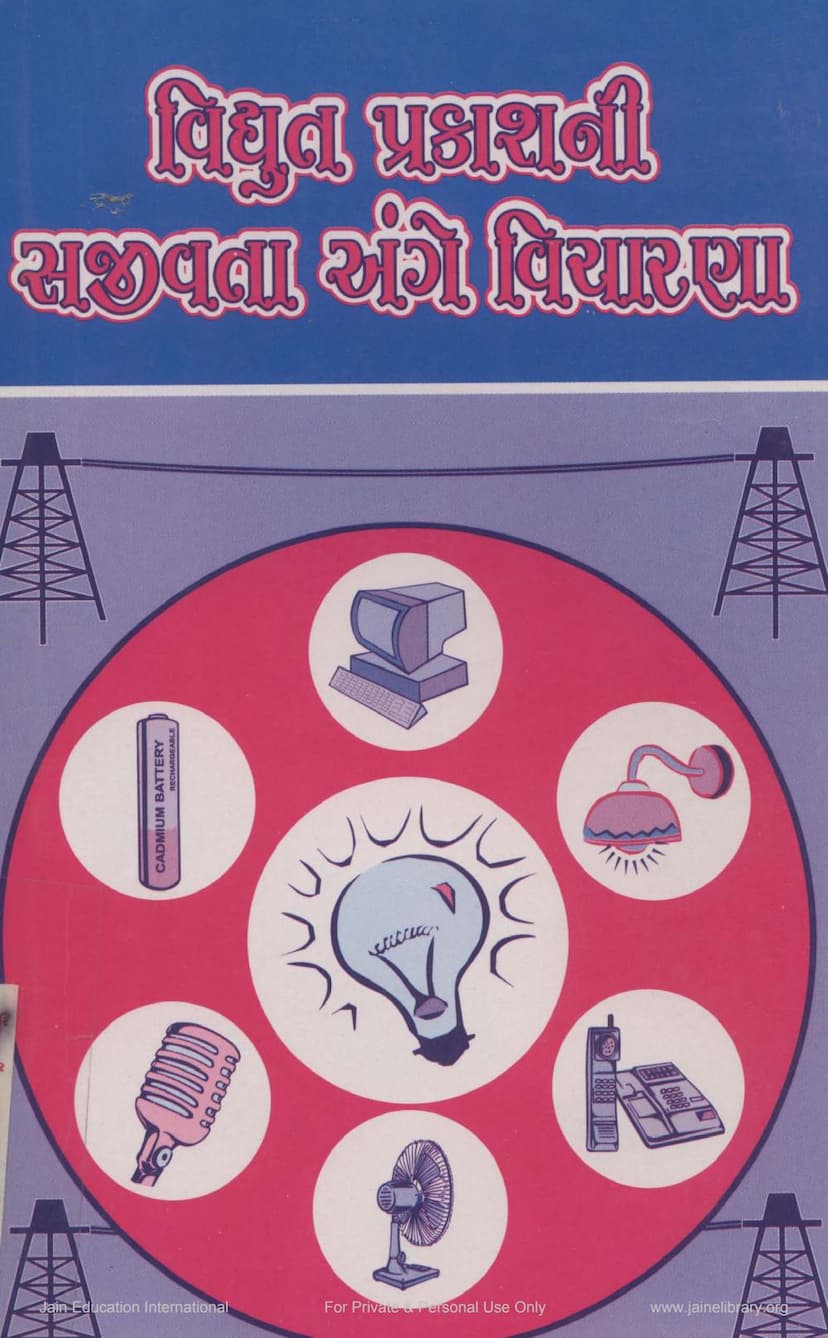Vidyut Prakashni Sajivta Ange Vicharna
Added to library: September 2, 2025

Summary
Here's a comprehensive summary of the Jain text "Vidyut Prakashni Sajivta Ange Vicharna" (Considering the Sentience of Electric Light) by Yashovijay Upadhyay, Yashovijay of Bhuvanbhanusuri, published by Divya Darshan Trust:
This book is a detailed examination and refutation of the argument that electricity and electric light are inanimate (achitta). The author, Muni Yashovijay, strongly asserts, based on Jain scriptures (Agamas), logic, and scientific principles, that electricity and electric light are indeed sentient (sachitta) and belong to the Agnikaya (fire element beings) classification.
The book originates from a discourse initiated by Acharya Mahapragya of the Terapanth sect, who declared electricity to be inanimate. Muni Yashovijay felt it was his duty to counter this view, which he believed was a deviation from established Jain tradition and potentially harmful to spiritual practice.
Key Arguments and Content:
-
The Nature of Agnikaya: The book meticulously explains the characteristics and various types of Agnikaya beings as described in Jain Agamas like the Pannavanasutra, Jivabhigamasutra, Acharyangasutra, and others. These Agamas detail numerous forms of fire-element beings, including sparks, embers, flames, lightning, and even the heat within glowing iron. The text emphasizes that understanding Agnikaya requires subtle intellect.
-
Electricity as Agnikaya: Muni Yashovijay argues that electricity, whether natural lightning or artificially generated, possesses the characteristics of Agnikaya.
- Scientific Evidence: The book integrates scientific findings, citing physicists like Michael Faraday and Benjamin Franklin. It explains that electricity is not merely energy but a tangible "charge" and a flow of electrons, which are considered subtle matter (pudgala). The author highlights that even modern science acknowledges the potential for matter and energy to transform into each other.
- Presence of Gas in Bulbs: The book refutes the idea of a complete vacuum in light bulbs. It cites scientific data indicating the presence of gases like nitrogen and argon, and arguments from Jain scholars like Malayagirighori that wherever there is a void, there is likely a Vayukaya (air element being). The author points to the carbon residue found in broken tube lights as evidence of gas presence and oxidation, which requires oxygen.
- Heat and Light as Agnikaya Indicators: The presence of heat and light in electrical phenomena (like glowing filaments, sparks, and electrical arcs) are presented as clear indications of Agnikaya life, as these are core characteristics of fire-element beings according to Jain philosophy. The author provides numerous examples from everyday life and scientific experiments (like Van de Graaff generators) to illustrate how electrical phenomena exhibit these life-indicating qualities.
- Friction and Agnikaya: The book explains how electricity is generated through friction in turbines, dynamos, and even in the simple act of striking a matchstick. It connects this to the Jain concept of Agnikaya being born from friction, as mentioned in the Agamas.
- Oxygen is Not Always Necessary for Combustion: The author addresses the scientific argument that fire needs oxygen. He presents scientific examples (like hydrogen burning in chlorine) and Jain arguments to show that combustion and heat production are possible even without oxygen, further strengthening the case for electricity's sentience.
- The "Subtle Fire" (Vidhyat Agnikaya): The book draws parallels between the Agamas' descriptions of "Vidhyat Agnikaya" (lightning or subtle fire beings) and electricity. It argues that electricity, like these described subtle fires, exists as a sentient being, even if not always outwardly manifest in a way perceived by ordinary senses.
-
Refutation of Acharya Mahapragya's Views: A significant portion of the book is dedicated to systematically dismantling the arguments made by Acharya Mahapragya. Muni Yashovijay critiques Mahapragya's reliance on mere scientific definitions of energy and particles without adequate consideration of Jain philosophical principles. He questions the claim that electricity is merely an "energy pulse" or "chemical pulse," arguing that this ignores the substantial evidence from Agamas and logical deduction for its sentient nature.
-
The Importance of Shrutagnana (Scriptural Knowledge): The author repeatedly emphasizes that discerning the true nature of subtle phenomena like electricity requires reliance on Shrutagnana (scriptural knowledge), which is the direct commentary and explanation of the Tirthankaras' teachings. He criticizes the tendency to prioritize modern science over scriptural wisdom when dealing with matters of spiritual and ethical import.
-
The Role of Vows and Conduct: The book strongly advocates that for Jain monks and nuns (sadhu-sadhvi), abstaining from electricity and electrical appliances is essential to uphold their vows of non-violence (ahimsa) and restraint. The author argues that the use of these appliances involves Himsa (violence) towards Agnikaya beings and also creates opportunities for other forms of violence and moral compromise (like attachment to worldly comforts and potential for indulgence).
-
Rejection of "Modernizing" Jain Principles: Muni Yashovijay expresses concern that attempts to adapt Jain principles to modern conveniences by declaring electricity inanimate are a form of "Usutra Prapana" (preaching non-scriptural doctrines) and a dilution of the core tenets of Jainism. He laments that this could lead to a weakening of discipline and a decline in the rigorous observance of vows.
-
Testimonials and Support: The book includes numerous endorsements from prominent Jain Acharyas and scholars from various sects (Murtipujak, Sthanakvasi, Terapanthi), who generally support Muni Yashovijay's conclusions and emphasize the importance of adhering to scriptural injunctions.
Conclusion:
"Vidyut Prakashni Sajivta Ange Vicharna" is a rigorous and comprehensive argument that, through the lens of Jain Agamas, logic, and scientific observation, electricity and electric light are sentient beings (Agnikaya). The author meticulously debunks the opposing view, particularly that of Acharya Mahapragya, and calls for strict adherence to traditional Jain practices regarding the non-use of electrical devices by monastics. The book serves as a strong defense of traditional Jain principles against the perceived influence of modern scientific interpretations that might lead to the relaxation of vows and ethical conduct.